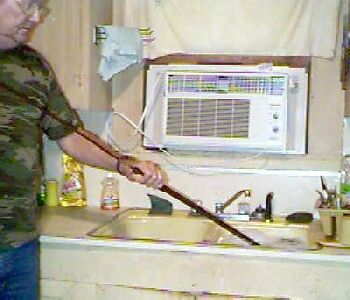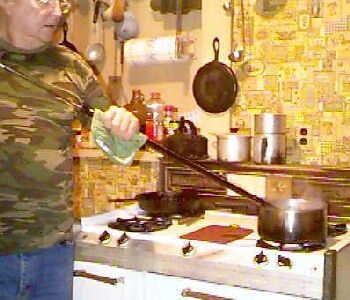|
Pay attention, class. We may have a pop quiz at the end of this lecture. Some of the concoctions some people use to clean their muzzleloaders would make a chemist cringe. I've used the same simple ingredients and method for over 20 years, and they have always removed all traces of black powder fouling and they have never—I repeat, never—allowed the barrels of my muzzleloading pistols or rifles to rust. Those ingredients are: The step by step method is:
As you work the swab back and forth the entire length of the barrel, it creates a suction, pulling hot soapy water inside the barrel through the nipple hole and the clean-out screw hole, then forcing it out of the barrel via the same two holes. Do this a dozen or more times or until you're positive your barrel is clean of fouling.
NOTE: I do not use a brass brush on the bores of my black powder firearms. I use a cotton swab or cleaning patch only. Over time, the bore of a black powder firearm will develop a patina much like the surface of a cast iron skillet. A brush removes that beneficial patina. Just as you shouldn't use soap on a cast iron skillet, you shouldn't use a metal brush on a black powder rifle bore.
The one exception to the brush rule is if your rifle has a patent breech. The bore diameter of my Crockett Rifle is .320". However, the base of the barrel contains an un-rifled chamber about .230" in diameter and about 1 ½" long. I use a .22 caliber brass brush to clean that chamber/patent breech.
Check your rifle. If it contains a patent breech and you don't know it, you haven't been cleaning it. If you've been getting erratic ignition, maybe now you know why. To check for a patent breech, run your ramrod down your unloaded barrel until it bottoms out. Mark the tip of the ramrod at the exit point of the barrel. Then remove the ramrod and place it beside the barrel, carefully positioning the mark on the tip even with the end of the barrel. Now look at the other end of the ramrod. If the end is even with the nipple hole and the clean-out hole, you either don't have a patent breech or the breech is the same diameter as the bore. If there's a distance between the end of the ramrod and the two holes—1 ½" in my case—your barrel has a patent breech. Now that your barrel is clean
If you're cleaning a black powder revolver, place the cylinder and the loading lever in the pot of boiling water and let them boil for a couple of minutes. While they boil, use a coffee cup and pour boiling water through the barrel from the cylinder end. Then place all parts on a towel or newspaper and let them dry.
When I return to the barrel it is totally dry and warm or even cool to the touch. I then oil the external surfaces with plain ol' 3-IN-ONE oil. For the bore, I use a sodium free vegetable oil. "Sodium free" means "salt free." To oil the chamber of my Crockett Rifle, I wrap a small, vegetable-oiled .22 caliber cleaning patch around a .22 caliber brass brush and run it in and out of the chamber several times. I then run at least four clean patches through the chamber to remove all but a microscopic trace of the oil.
That's all there is to cleaning a muzzleloader. Just reinstall the nipple and clean-out screw in the barrel and reinstall the barrel in the stock. One word of bought advice: put a tiny daub of anti-seize compound on the threads of the nipple and the clean-out screw. The 1 oz tube I use cost about $2 at Ace Hardware. I figure it will last me the rest of my shooting life. If you don't spend that $2, I can guarantee you that sooner or later a gunsmith will tell you, as one told me: "I know it didn't take me but five minutes to remove that stuck screw, but we got a $40 minimum charge in this shop."
|
 Here you see me swabbing the barrel of my little .32 caliber Traditions Crockett Rifle, a squirrel killin' dandy, a round ball shootin' marvel.
Here you see me swabbing the barrel of my little .32 caliber Traditions Crockett Rifle, a squirrel killin' dandy, a round ball shootin' marvel.